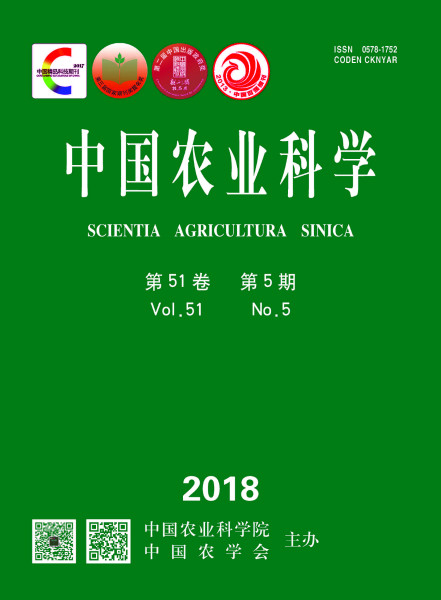-
Effects of Drought Stress on Root and Physiological Responses of Different Drought-Tolerant Alfalfa Varieties
- ZHANG CuiMei, SHI ShangLi, WU Fang
-
Scientia Agricultura Sinica. 2018, 51(5):
868-882.
doi:10.3864/j.issn.0578-1752.2018.05.006
-
 Abstract
(
789 )
Abstract
(
789 )
 HTML
(
50 )
HTML
(
50 )
 PDF (470KB)
(
741
)
PDF (470KB)
(
741
)
 Save
Save
-
References |
Related Articles |
Metrics
【Objective】This study aimed to understand the differential growth and physiological response in roots of different drought-tolerant alfalfa varieties to drought stress, and to provide theoretical basis for further clarifying the molecular mechanism of alfalfa against drought and for improving drought tolerance and water use efficiency in alfalfa.【Method】In a sand culture experiment, three different drought-tolerant alfalfa varieties, including Medicago sativa L. cv. Longzhong (strong drought-tolerant), Medicago sativa L. cv. Longdong (moderate drought-tolerant), and Medicago sativa L. cv. Gannong No.3 (drought-susceptible), were treated with drought stress induced by polyethylene glycol-6000 (PEG-6000) solutions of different osmotic potentials (0.0, -0.4, -0.8, -1.2, -1.6 and -2.0 MPa). The root growth characters of total root length, total root surface area, average root diameter, root volume, root tip number and root dry weight, root activity, the contents of free proline, soluble protein, and soluble sugar, relative permeability of plasma (RPP), the levels of malondialdehyde (MDA) and reactive oxygen species (ROS), the activities of superoxide dismutase (SOD), peroxidase (POD) and catalase (CAT), and reduced ascobate (AsA) and reduced glutathione (GSH) contents were measured at seedling stage. Moreover, stepwise regression analysis was used to establish the optimal regression equation that could select the influential indices for drought-tolerance of the alfalfa varieties under different drought stress levels.【Result】Drought stress has an obvious effect on growth and physiological traits of the alfalfa varieties. With increasing drought stress, the free proline contents, the levels of MDA, RPP and ROS (H2O2, OH· and O2•-), and CAT activity in roots of three alfalfa varieties were significantly increased, while root dry weight, root activity, and the contents of soluble sugar and GSH were firstly increased and then decreased. Additionally, as the osmotic potentials of solutions decreased, average root diameter, root volume, root tip number, POD and SOD activities of Longzhong increased first and then decreased, whereas the above first four indicators and total root surface area of Longdong and Gannong No.3 decreased continuously. Moreover, with the increase of stress, the AsA content of Longzhong continuously increased but that of the other two varieties increased first and then decreased. Overall, total root length, total root surface area and root dry weight in roots of Longzhong were significantly greater than those of Longdong and Gannong No.3, while the H2O2 and OH· levels in roots of Longzhong were significantly lower than those of Gannong No.3. The contents of soluble protein, soluble sugar and MDA in roots of Longzhong and Longdong were obviously lower than those of Gannong No.3. Under the drought stress from -1.2 to -2.0 MPa, the H2O2 and OH· contents in roots of Longzhong were significantly lower than those of Longdong. Under -2.0 MPa, the AsA and GSH contents and POD activity in roots of Longzhong were significantly higher than those of Gannong No.3. The result of stepwise regression analysis showed that root activity, root volume, total root length, MDA and AsA were the most influential indices for drought-tolerance of Longzhong; Root tip number, average root diameter, total root surface area, root dry weight, O2•-, GSH and CAT were the most influential indices for drought-tolerance of Longdong; and root activity, root tip number, free proline, soluble sugar, MDA, RPP and GSH were the most influential indices for drought-tolerance of Gannong No.3.【Conclusion】The alfalfa varieties with different drought-tolerance exhibit common and divergent responses to drought stress at the morphological and physiological levels. Under light and mild drought stress conditions (osmotic potentials decreased from 0 MPa to -1.2 MPa), drought-tolerant alfalfa varieties mainly adapted to drought by increasing the root length, root volume and root tip number and reducing the degree of membrane lipid peroxidation, while drought-susceptible alfalfa varieties adapted to drought by changing cell membrane stability, root activity and osmotic adjustment. Under severe drought stress (osmotic potentials declined from -1.2 MPa to -2.0 MPa), the alteration of root growth and activation of antioxidant system were common response mechanisms of tested alfalfa varieties. Furthermore, strong drought-tolerant alfalfa variety increased total root length and AsA content against drought stress, while moderate drought-tolerant and drought-susceptible alfalfa varieties increased root tip number and GSH content in response to drought stress.









